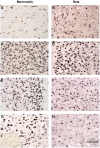The pattern of c-Fos expression and its refractory period in the brain of rats and monkeys
- PMID: 25814929
- PMCID: PMC4357304
- DOI: 10.3389/fncel.2015.00072
The pattern of c-Fos expression and its refractory period in the brain of rats and monkeys
Abstract
Intense activation of neurons triggers the appearance of immediate expression genes, including c-Fos. This gene is related to various signal cascades involved in biochemical processes such as neuronal plasticity, cell growth and mitosis. Here we investigate the expression pattern and the refractory period of c-Fos in rats and monkey's brains after stimulation with pentylenetetrazol. Rats and monkeys were sacrificed at various times after PTZ-induced seizure. Here we show that rats and monkeys already showed c-Fos expression at 0.5 h after seizure. Yet, the pattern of protein expression was longer in monkeys than rats, and also was not uniform (relative intensity) across different brain regions in monkeys as opposed to rats. In addition monkeys had a regional brain variation with regard to the temporal profile of c-Fos expression, which was not seen in rats. The refractory period after a second PTZ stimulation was also markedly different between rats and monkeys with the latter even showing a summatory effect on c-Fos expression after a second stimulation. However, assessment of c-Fos mRNA in rats indicated a post-transcriptional control mechanism underlying the duration of the refractory period. The difference in the protein expression pattern in rodents and primates characterizes a functional aspect of brain biochemistry that differs between these mammalian orders and may contribute for the more developed primate cognitive complexity as compared to rodents given c-Fos involvement in cognitive and learning tasks.
Keywords: brain plasticity; c-Fos expression; marmosets; neuronal activation; phylogeny.
Figures




Similar articles
-
Marmosets have a greater diversity of c-Fos response after hyperstimulation in distinct cortical regions as compared to rats.J Comp Neurol. 2021 May 1;529(7):1628-1641. doi: 10.1002/cne.25044. Epub 2020 Oct 7. J Comp Neurol. 2021. PMID: 32975324
-
c-Jun expression after cerebral hyperstimulation differs between rats and marmosets.J Neurosci Res. 2019 Jul;97(7):760-771. doi: 10.1002/jnr.24399. Epub 2019 Mar 2. J Neurosci Res. 2019. PMID: 30825347
-
C-Fos mapping and EEG characteristics of multiple mice brain regions in pentylenetetrazol-induced seizure mice model.Neurol Res. 2019 Aug;41(8):749-761. doi: 10.1080/01616412.2019.1610839. Epub 2019 Apr 30. Neurol Res. 2019. PMID: 31038018
-
Comparative fos immunoreactivity in the brain after forebrain, brainstem, or combined seizures induced by electroshock, pentylenetetrazol, focally induced and audiogenic seizures in rats.Neuroscience. 2004;123(1):279-92. doi: 10.1016/j.neuroscience.2003.08.015. Neuroscience. 2004. PMID: 14667462
-
Pentylenetetrazole (PTZ)-induced c-fos expression in the hippocampus of kindled rats is suppressed by concomitant treatment with naloxone.Brain Res. 1998 May 11;792(2):299-308. doi: 10.1016/s0006-8993(98)00159-0. Brain Res. 1998. PMID: 9593956
Cited by
-
Structure and function differences in the prelimbic cortex to basolateral amygdala circuit mediate trait vulnerability in a novel model of acute social defeat stress in male mice.Neuropsychopharmacology. 2022 Feb;47(3):788-799. doi: 10.1038/s41386-021-01229-6. Epub 2021 Nov 19. Neuropsychopharmacology. 2022. PMID: 34799681 Free PMC article.
-
Delay eyeblink conditioning performance and brain-wide c-Fos expression in male and female mice.Open Biol. 2023 May;13(5):220121. doi: 10.1098/rsob.220121. Epub 2023 May 10. Open Biol. 2023. PMID: 37161289 Free PMC article.
-
An infralimbic cortex engram encoded during learning attenuates fear generalization.J Neurosci. 2025 Mar 27;45(19):e2120242025. doi: 10.1523/JNEUROSCI.2120-24.2025. Online ahead of print. J Neurosci. 2025. PMID: 40147934
-
Cannabidiol Produces Distinct U-Shaped Dose-Response Effects on Cocaine-Induced Conditioned Place Preference and Associated Recruitment of Prelimbic Neurons in Male Rats.Biol Psychiatry Glob Open Sci. 2022 Jan;2(1):70-78. doi: 10.1016/j.bpsgos.2021.06.014. Epub 2021 Jul 7. Biol Psychiatry Glob Open Sci. 2022. PMID: 35252951 Free PMC article.
-
Functional Ontogeny of Hypothalamic Agrp Neurons in Neonatal Mouse Behaviors.Cell. 2019 Jun 27;178(1):44-59.e7. doi: 10.1016/j.cell.2019.04.026. Epub 2019 May 16. Cell. 2019. PMID: 31104844 Free PMC article.
References
-
- Baille-Le Crom V., Collombet J. M., Burckhart M. F., Foquin A., Pernot-Marino E., Rondouin G., et al. . (1996). Time course and regional expression of c-Fos and HSP70 in hippocampus and piriform cortex following soman-induced seizures. J. Neurosci. Res. 45, 513–524. 10.1002/(sici)1097-4547(19960901)45:5<513::aid-jnr1>3.0.co;2-f - DOI - PubMed
-
- Bisler S., Schleicher A., Gass P., Stehe J. H., Zilles K., Staiger J. F. (2002). Expression of c-Fos, ICER, Krox-24 and JunB in the whisker-to-barrel pathway of rats: time course of induction upon whisker stimulation by tactile exploration of an enriched environment. J. Chem. Neuroanat. 23, 187–198. 10.1016/s0891-0618(01)00155-7 - DOI - PubMed
-
- Blanco M. M., dos Santos J. G., Jr., Perez-Mendes P., Kohek S. R. B., Cavarsan C. F., Hummel M., et al. . (2009). Assessment of seizure susceptibility in pilocarpine epileptic and nonepileptic Wistar rats and of seizure reinduction with pentylenetetrazole and electroshock models. Epilepsia 50, 824–831. 10.1111/j.1528-1167.2008.01797.x - DOI - PubMed
LinkOut - more resources
Full Text Sources
Other Literature Sources

